This article was originally published in 2015.
For updated info on our standard neck profiles, please click here: Halo Standard Neck Profiles
For updated info on our standard neck profiles, please click here: Halo Standard Neck Profiles
The part of the guitar we come into contact with most is the neck, so it’s crucial for certain areas of the neck to be thoughtfully designed and carefully crafted to allow for maximum comfort and ease of playing.
The “perfect” neck should feel like a natural extension of your body, not a foreign object in your grips. It should be a joy to play, not a chore. Setup and string gauges aside, let’s talk about some of the key areas that influence the way our guitar necks “feel” in terms of how they’re crafted.
- The Neck Profile: refers to the shape/curvature and thickness of the back of the neck where your thumb is anchored when playing
- The Fretboard Radius: refers to the curvature of the front of the neck where your fingers are placed when fretting
- The Fret Size: refers to the width and height of the actual fret wire that is installed in the fretboard
Many players find the Neck Profile makes the biggest impact on how a guitar’s neck feels. Halo's standard neck profile is a moderately thin, “C” shaped neck with a 16" radius and jumbo frets.
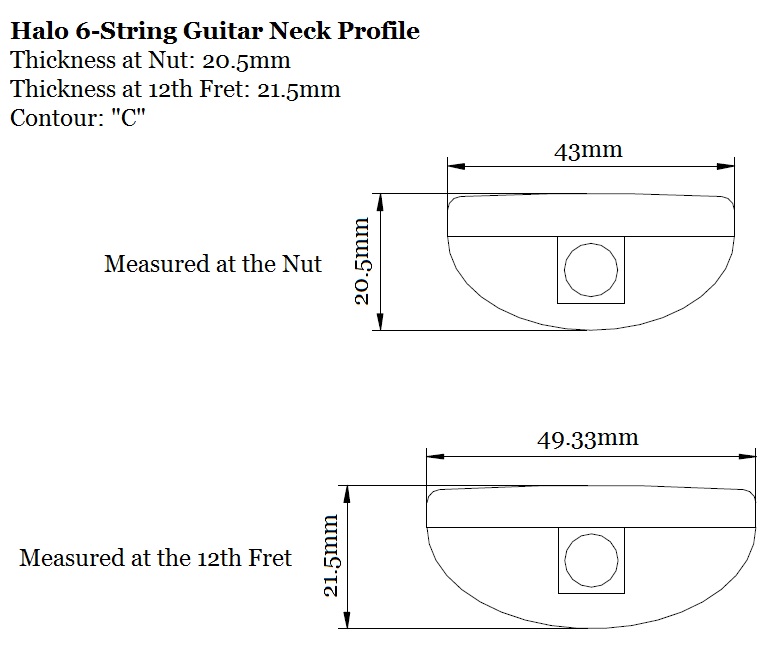
Halo 6-String Guitar Neck Profile (not drawn to scale)
The standard Halo neck profile is thin enough that it plays and feels very “fast”, yet thick enough that there is enough wood to grab onto and doesn’t become fatiguing to play. There are three basic groupings in terms of thicknesses:
- Thin: any neck with a 17-19mm thickness at the nut
- Medium: any neck with a 20-22mm thickness at the nut
- Thick: any neck with a 23mm+ thickness at the nut
It’s helpful to know these kinds of precise measurements when shopping around for a guitar online, or when considering a custom build. The reason is because you can’t just pick up and try out a guitar unless it’s already built and in front of you. You’ve got to have something to go by. Because a “thin” neck for one person might be a "thick” neck for another person. But, a 20mm neck is a 20mm neck, end of story.
The front of the neck (fretboard) impacts the way the neck feels, but in a relatively subtle way. First, the fretboard itself is not usually flat (unless we’re talking classical guitars), but has a radius, or curvature. The fretboard radius helps the front of the neck conform to the natural curvature of our fingers (as we close our fists, our fingers curl inward) and should make the guitar more comfortable to play. A smaller radius (like 7.25”) is more curved and a larger radius (like 20”) is more flat. There are benefits and drawbacks to both:
A smaller radius is more comfortable for playing chords, but big string bends get "choked" out. The smaller radius may also reduce legato and tapping speeds.
A larger radius helps increase legato and tapping speeds. It also allows for big string bends without choking out. The only downside is that it might be less comfortable for playing chords.
Most guitars have a single radius that is consistent across the length of the fretboard. On the small end of the spectrum, we have something like a 7.25” radius, which can be found on some vintage Fender instruments. On the large end of the spectrum, we have something like a 30” radius, which can be found on some classical guitars that aim to be nearly flat, but have a very slight curvature. Halo fretboards are typically in the range of 16” to 20”. We use a smaller radius on our relatively narrower necks and a larger radius on our relatively wider necks. For example, our 6-string guitars typically have a 16” radius, whereas our 8-string guitars typically have a 20” radius. We find that a radius between 16” to 20” gets most of the benefits from both worlds: comfortable for chording, great for shredding/tapping and worry-free for big string bends. We also offer compound radius fretboards, which just means the fretboard has more than one radius on it (smaller radius near the nut; larger radius near the last fret).
Lastly, the size of the fret wire also makes a difference in feel. It is very subtle, but noticeable. Fret wire is available in a variety of different widths and heights. To simplify things, we'll consider three widths:
- Narrow
- Medium
- Wide
And three heights:
- Short
- Medium
- Tall
Narrow fret wire has two main benefits. The first is that it can provide slightly better intonation over the lifetime of the instrument compared to wide fret wire. But, most people probably won't hear the difference and some simple fret maintenance would make this a moot point. Why can intonation be better with narrow wire? Because the tops of the frets should be round (not flat), . That means that when we push a string down against the fret, the string comes in to contact with the fret wire at the center of the fret wire. This is good because the center of the fret wire is where the note is supposed to intonate. But, over time, the fret wire becomes worn and instead of having a round top, it has a flat top. This means that when we push a string down against the fret, the string is no longer coming in to contact with the center of the fret wire, but somewhere off-center (nearer to the bridge). This tiny amount of distance can affect the intonation. A second, and probably more noticeable benefit, is that narrow wire takes up less space on the fretboard. There is more than enough space between frets in the lower fret region to where narrow or wide frets don’t really make a difference. But, the spacing gets pretty tight and limited as we approach the upper frets on a 24 fret guitar. This is where narrow wire comes in handy. With narrow wire, it’s easier for our fingertips to cleanly fret those highest frets and to be able to dig in deep for string bends. If this isn’t making sense, just imagine how much easier it is to take a seat on a bus/train between two ballerinas compared to two sumo wrestlers. The ballerinas are the narrow frets, the sumo wrestlers the wide frets, and you are the fingertips.
Wide fret wire has one main benefit and that is it lasts longer. It lasts longer because there is more material there for the string to wear though. Medium fret wire is the happy medium between narrow and wide. In terms of feel, we don’t think fret width makes the most significant impact.
Fret height, though, can make a noticeable difference in the feel of a neck. On one end of the spectrum, we have short wire, which allows our fingertips to come into contact with the fretboard wood itself. On the other end of the spectrum, we have tall wire, which pushes our fingertips above and away from the fretboard wood itself. This makes it less likely for our fingertips to touch the surface of the fretboard. Here’s a chart to show some benefits and drawbacks I could think of:

Fret Height Benefits and Drawbacks Chart
The standard fret wire on Halo instruments is Wide & Tall (Jumbo).
Hopefully this article has given you a better understanding of why we design and craft our necks the way we do... because we believe they'll play faster, better and longer!
What kind of neck profile and frets do you prefer? Leave us a comment below.
Here are some additional Halo Guitar Neck Profiles:

Halo 6-String Guitar Neck Profile (not drawn to scale)
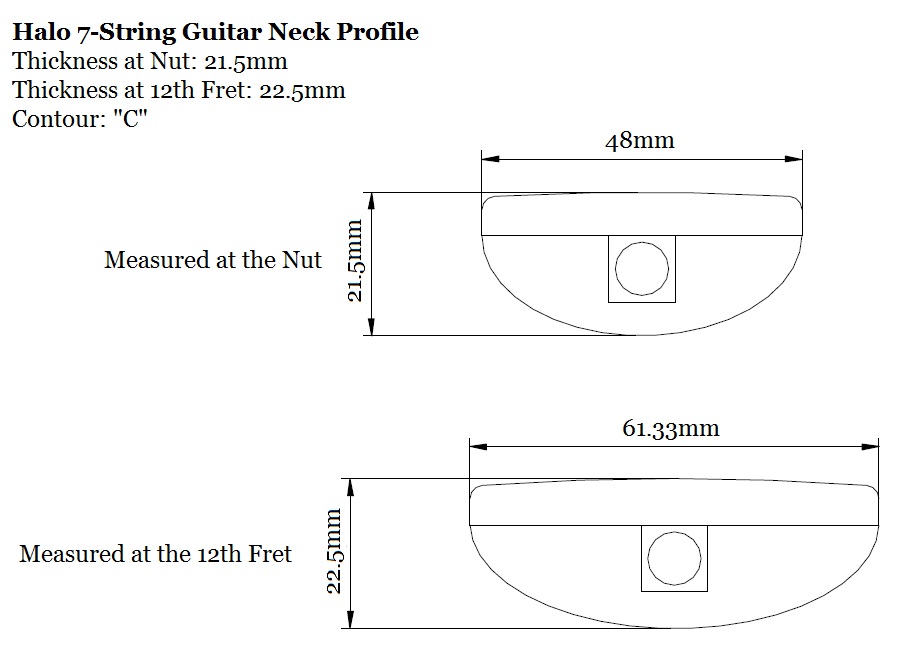
Halo 7-string Guitar Neck Profile (not drawn to scale)
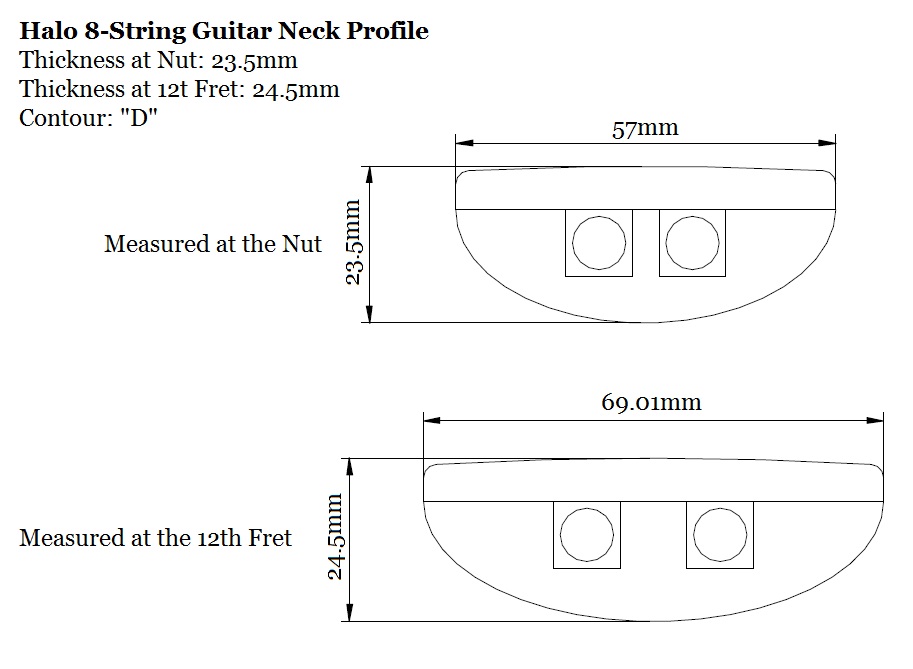
9/22/2020 Update: 8-string nut width is 54mm, not 57mm
Halo 8-string Guitar Neck Profile (not drawn to scale)
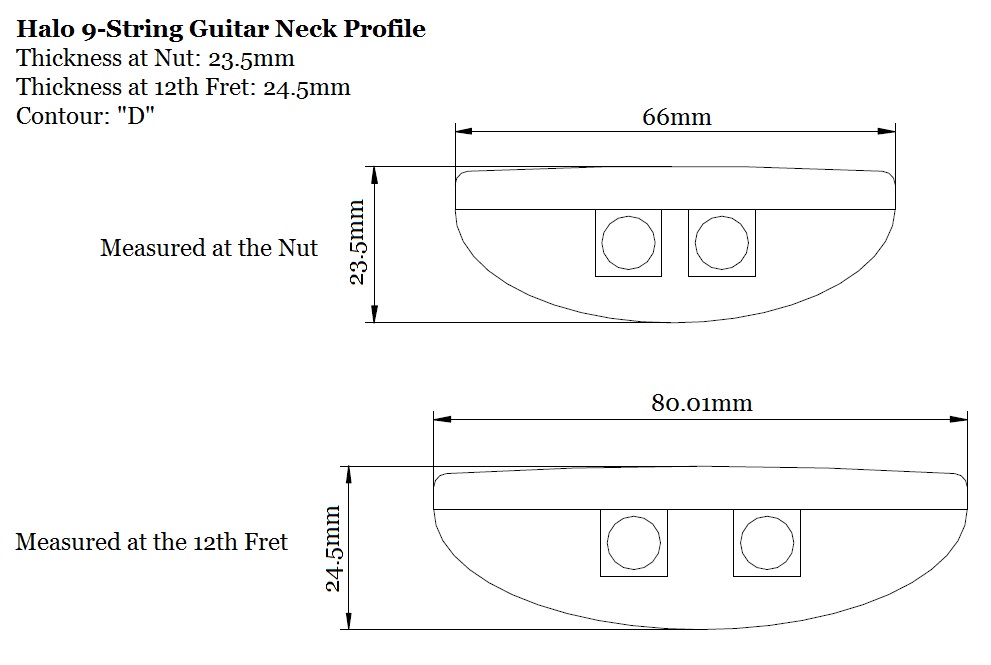
Halo 9-string Guitar Neck Profile (not drawn to scale)
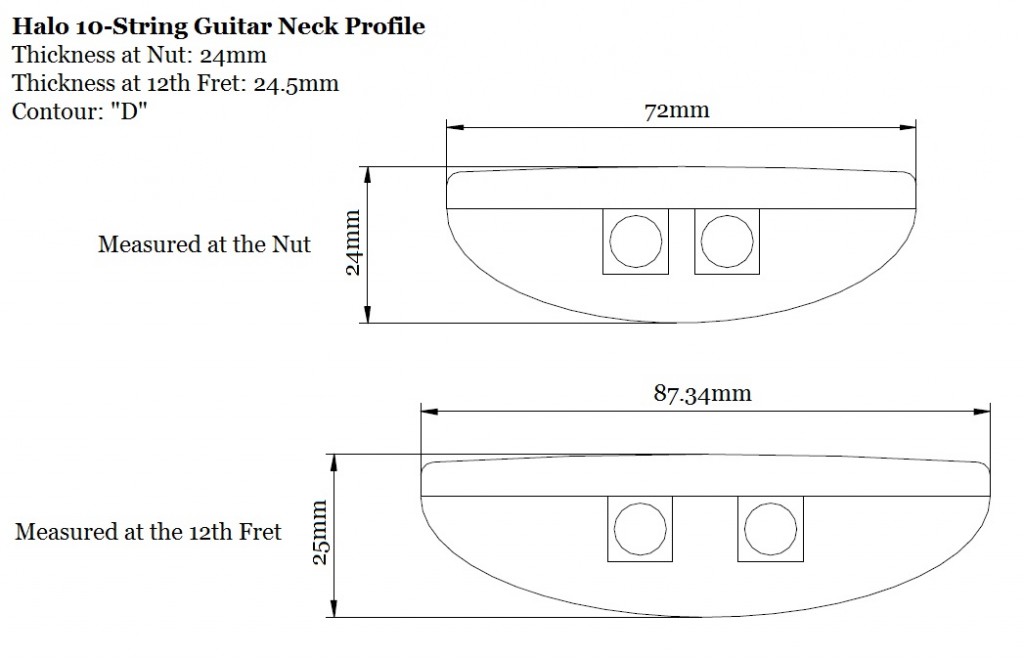
Halo 10-string Guitar Neck Profile (not drawn to scale)
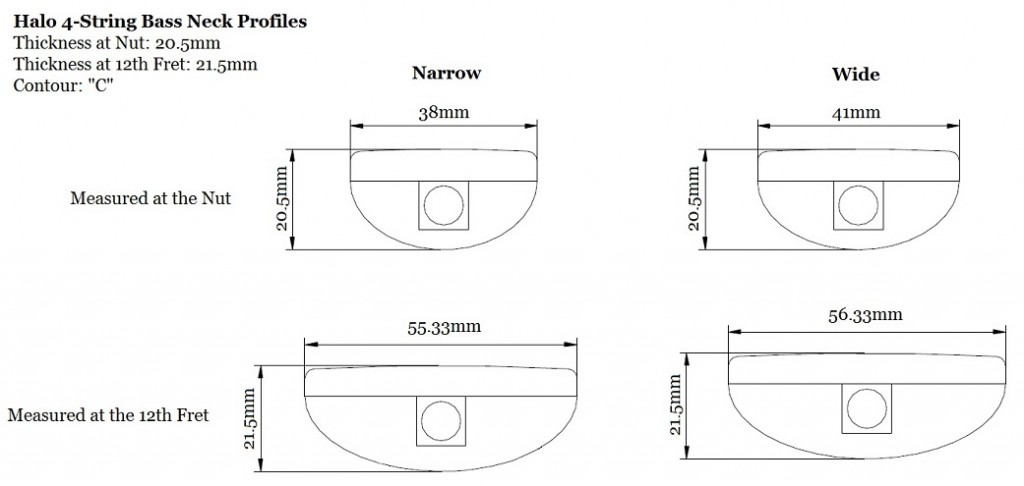
Halo 4-String Bass Guitar Neck Profiles (not drawn to scale)
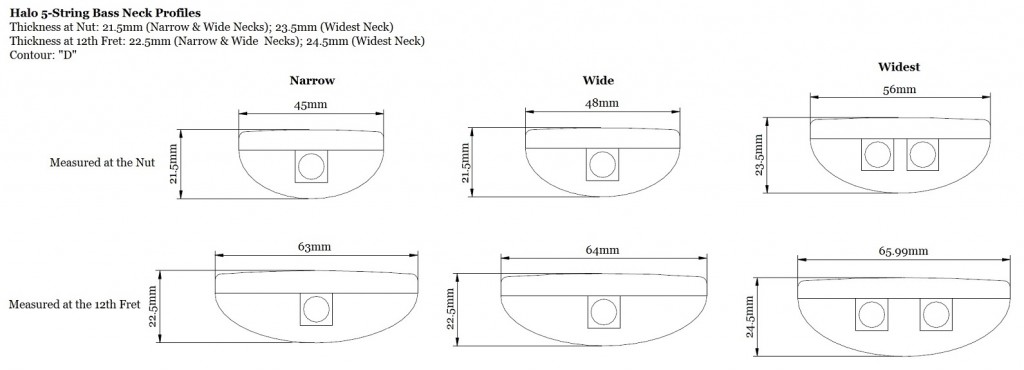
Halo 4-String Bass Guitar Neck Profiles (not drawn to scale)
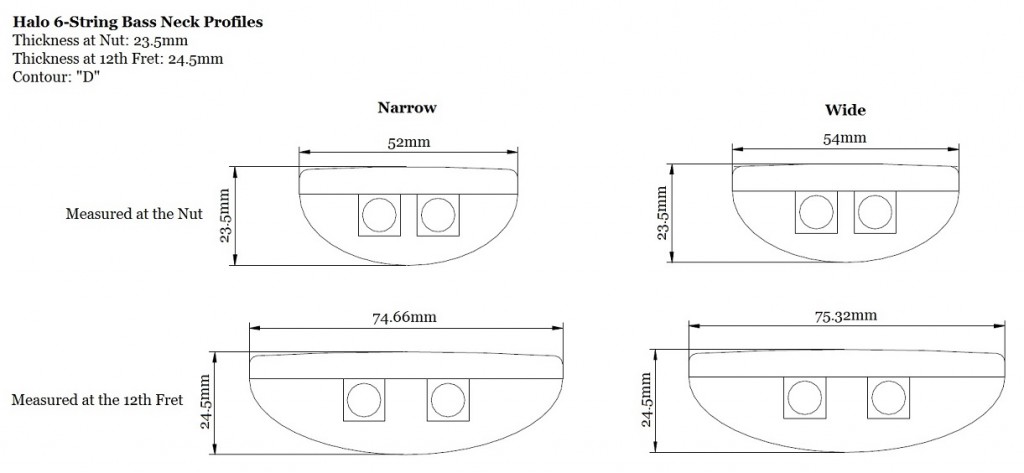
Halo 6-String Bass Guitar Neck Profiles (not drawn to scale)
Comments: 5
Leave a Reply
Your email address cannot be published. Required fields are marked*
Blog Search
Categories


Gracias por aportar esta importante información gráfica. Pero la que buscaba era la del bass.
We are working on the bass neck profiles, but we'll email you to provide the info you're looking for. Thank you - Halo Custom Guitars